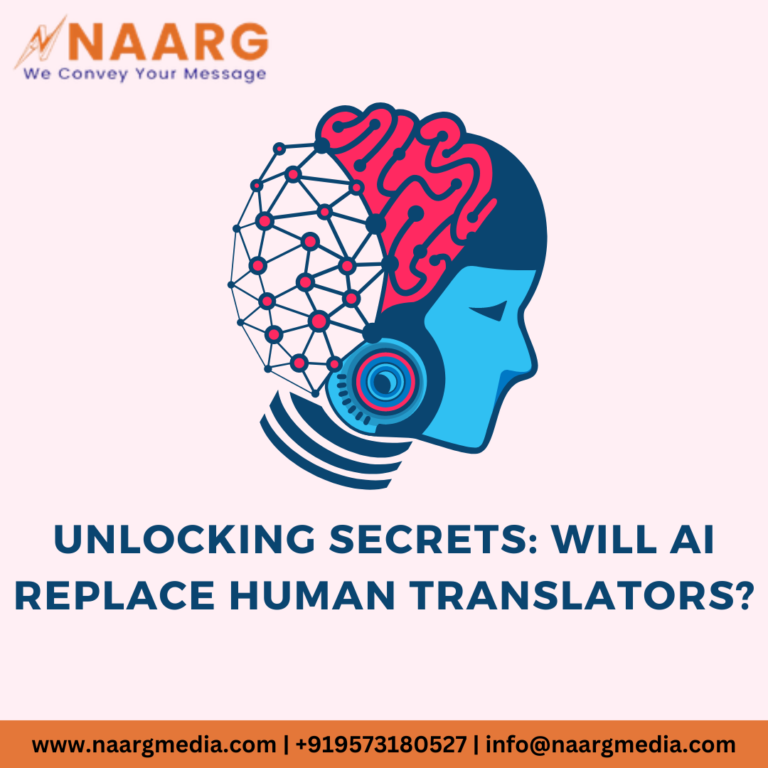Will AI replace human translators? The age-old debate about AI taking over our jobs, but the answer is NO. AI is not here to take over our jobs or replace human translators.
Sure, they have some language skills and have provided impressive results in recent years. But they can not give the human touch, like cultural nuances and idiomatic expressions; these are the contexts that AI finds hard to replicate. And it is unlikely that AI will replace human translators. It can become a helping hand for your projects.
In this blog post, we will tell you about the key differences between AI and human translators, and you will find an answer to your question: will AI replace translators?
So, let’s get started.

AI vs. Human Translators
This battle between AI and human translators is long-lived. But to understand both, you have to understand the key differences between AI and human translators and what makes them unique. Here we have listed key differences between AI and human translators.
1. Speed and Cost of Translation
There is no doubt that machines are faster than professional human translators, and they speed up the translation process. Machine Translation engines can now translate an entire novel in just two minutes. This speed also comes with an effective translation cost and benefits your business.
Let’s give you an example: Imagine you are just beginning to expand your business overseas and have a constrained budget. Here Artificial Intelligence promises a quicker turnaround time and can be cost-effective for your business. And some reports also say that global Artificial Intelligence is growing at a CAGR of 40%. (Grand View Research).
On the other hand, professional translators require time and investment for a translation project. And for some translation processes, you may not even need interpreters and translators. The job can be done by artificial intelligence only. So, When accuracy is not of high importance, you can surely go with machine translation instead of professional translators.
2. Cultural Nuances
We all know that artificial intelligence and AI translators do not understand cultural connotations. Artificial Intelligence cannot pick on references. On the other hand, professional translators who are trained in the target language can easily delve deeper and make informed decisions considering the cultural background of the target audience.
They can recognize the tone and idiomatic expressions that resonate with the audience. When it comes to culturally appropriate translation processes, professionals can prevent mistranslations by avoiding cultural mistakes.
So if you are looking for high-quality content that connects with the audience on an emotional level, then professional human translators are the right choice for you.
3. Context
We all know that context is the key to any translation process. And artificial intelligence struggles with polysemy, i.e., the existence of many meanings for a phrase or a word. AI translation tools generally fail to catch different contexts for the same words. For instance, running a marathon or running a meeting. Sometimes the literal translation of the context i.e., word for word translation can cause huge disasters. And will give you an awkward translation.
On the other hand, professional translators will be quick to catch and correlate the word according to context. AI translators often miss these nuances, and the context fails to engage the desired audience.
4. Keeping up with trends
Whenever there is new slang and idioms, it takes time for the artificial intelligence database to update. So sometimes you may find neural machine translation a bit dated. And in contrast to professional human translators, they are aware of the recent catchphrases and buzzwords for a specific target culture.
It has become very essential to keep tabs on current trends so that businesses can appeal to potential customers. Machine translation technology has a long way to go before it can keep up with trends. We cannot rely on machine translation work as it requires constant proofreading for potential errors.
You cannot afford to have culturally disconnected content.
Will AI replace human translators?
There is no doubt that artificial intelligence and machine translation tools have improved in recent years, but they still cannot replace human translators. Artificial intelligence still struggles to understand tone of voice, context, and colloquial nuances. Yes, Neural machine translation has emerged as a huge help when it comes to speeding up the translation process. But still, you will require a professional human translator to proofread and edit the translations.
In healthcare, inaccurate translation can have serious consequences. Let’s give you an example: During the COVID-19 pandemic, in Virginia, many episodes of mistranslation were seen. One such instance was when machine translation translated ‘vaccine is not required’ into ‘vaccine is not necessary’ in Spanish.
This mistake comes from a place where Spanish is the second-most spoken language in the U.S. And According to reports, Spanish is the fourth-most spoken language in the world.
These mistakes during a public health crisis can have huge repercussions. Just imagine if the machine translation cannot get the fourth most spoken language in the world right. How can we be sure that it will translate the least common languages with accuracy?
But never say no to any future advancements. Sure, in the upcoming years, artificial intelligence and machine translation processes will improve their accuracy.
But for now, AI translators need to be supervised by professional human translators.
Reach us at info@naargmedia.com to learn more about our services.



